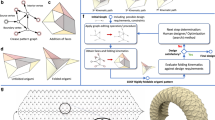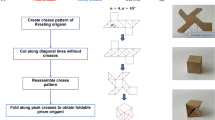Abstract
Origami is rapidly transforming the design of robots1,2, deployable structures3,4,5,6 and metamaterials7,8,9,10,11,12,13,14. However, as foldability requires a large number of complex compatibility conditions that are difficult to satisfy, the design of crease patterns is limited to heuristics and computer optimization. Here we introduce a systematic strategy that enables intuitive and effective design of complex crease patterns that are guaranteed to fold. First, we exploit symmetries to construct 140 distinct foldable motifs, and represent these as jigsaw puzzle pieces. We then show that when these pieces are fitted together they encode foldable crease patterns. This maps origami design to solving combinatorial problems, which allows us to systematically create, count and classify a vast number of crease patterns. We show that all of these crease patterns are pluripotent—capable of folding into multiple shapes—and solve exactly for the number of possible shapes for each pattern. Finally, we employ our framework to rationally design a crease pattern that folds into two independently defined target shapes, and fabricate such pluripotent origami. Our results provide physicists, mathematicians and engineers with a powerful new design strategy.
This is a preview of subscription content, access via your institution
Access options
Access Nature and 54 other Nature Portfolio journals
Get Nature+, our best-value online-access subscription
$29.99 / 30 days
cancel any time
Subscribe to this journal
Receive 12 print issues and online access
$209.00 per year
only $17.42 per issue
Buy this article
- Purchase on Springer Link
- Instant access to full article PDF
Prices may be subject to local taxes which are calculated during checkout



Similar content being viewed by others
Data availability
The data that support the plots within this paper and other findings of this study are available from the corresponding author upon request.
References
Felton, S., Tolley, M., Demaine, E., Rus, D. & Wood, R. A method for building self-folding machines. Science 345, 644–646 (2014).
Miskin, M. Z. et al. Graphene-based bimorphs for micron-sized, autonomous origami machines. Proc. Natl Acad. Sci. USA 115, 466–470 (2018).
Miura, K. Method of Packaging and Deployment of Large Membranes Report No. 618 (Institute of Space and Astronautical Science, 1985).
Kuribayashi, K. et al. Self-deployable origami stent grafts as a biomedical application of Ni-rich TiNi shape memory alloy foil. Mat. Sci. Eng. A 419, 131–137 (2006).
Wilson, L., Pellegrino, S., & Danner, R. Origami inspired concepts for space telescopes. In 54th AIAA/ASME/ASCE/AHS/ASC Structures, Structural Dynamics, and Materials Conference (2013).
Evgueni, T. P., Tachi, T. & Paulino, G. H. Origami tubes assembled into stiff, yet reconfigurable structures and metamaterials. Proc. Natl Acad. Sci. USA 112, 12321–12326 (2015).
Schenk, M. & Guest, S. D. Geometry of Miura-folded metamaterials. Proc. Natl Acad. Sci. USA 110, 3276–3281 (2013).
Silverberg, J. L., Evans, A. A., McLeod, L. & Hayward, R. C. Using origami design principles to fold reprogrammable mechanical metamaterials. Science 345, 647–650 (2014).
Waitukaitis, S., Menaut, R., Chen, B. G. & van Hecke, M. Origami multistability: from single vertices to metasheets. Phys. Rev. Lett. 114, 055503 (2015).
Silverberg, J. L. et al. Origami structures with a critical transition to bistability arising from hidden degrees of freedom. Nat. Mater. 14, 389–393 (2015).
Chen, B. G. et al. Topological mechanics of origami and kirigami. Phys. Rev. Lett. 116, 113501 (2016).
Dudte, L. H., Vouga, E., Tachi, T. & Mahadevan, L. Programming curvature using origami tessellations. Nat. Mater. 15, 583–588 (2016).
Overvelde, J. T. B., Weaver, J. C., Hoberman, C. & Bertoldi, K. Rational design of reconfigurable prismatic architected materials. Nature 541, 347–352 (2017).
Bertoldi, K., Vitelli, V., Christensen, J. & van Hecke, M. Flexible mechanical metamaterials. Nat. Rev. Mat. 2, 17066 (2017).
Lang, R. J. Origami Design Secrets: Mathematical Methods for an Ancient Art 2nd edn (Taylor and Francis, 2011).
Ginepro, J. & Hull, T. C. Counting Miura-ori foldings. J. Int. Seq. 17, 14108 (2014).
Arkin, E. M. et al. When can you fold a map? Comp. Geom. 29, 23–46 (2004).
Waitukaitis, S. & van Hecke, M. Origami building blocks: generic and special four-vertices. Phys. Rev. E 93, 023003 (2016).
Chen, B. G. & Santangelo, C. D. Branches of triangulated origami near the unfolded state. Phys. Rev. X 8, 011034 (2018).
Evans, A. A., Silverberg, J. L. & Santangelo, C. D. Lattice mechanics of origami tessellations. Phys. Rev. E 92, 013205 (2015).
Barreto, P. T. Lines meeting on a surface: the ‘Mars’ paperfolding. In Proc. 2nd International Meeting of Origami Science and Scientific Origami (ed. Miura, K.) 323–331 (Tokyo Seian University of Art and Design, 1997).
Huffman, D. A. Curvature and creases: a primer on paper. IEEE Trans. Comp. C 25, 1010–1019 (1976).
Tachi, T. Generalization of rigid foldable quadrilateral mesh origami. J. Int. Assoc. Shell Spat. Struct. 50, 173–179 (2009).
Kokotsakis, A. Uber bewegliche Polyeder. Math. Ann. 107, 627–647 (1933).
Stern, M., Pinson, M. B. & Murugan, A. The complexity of folding self-folding origami. Phys. Rev. X 7, 041070 (2017).
belcastro, S.-M. & Hull, T. C. Modeling the folding of paper into three dimensions using affine transformations. Lin. Alg. Appl. 348, 273–282 (2002).
Izmestiev, I. Classification of flexible kokotsakis polyhedra with quadrangular base. Int. Math. Res. Not. 3, 715–808 (2017).
Stachel, H. Flexible polyhedral surfaces with two flat poses. Symmetry 7, 774–787 (2015).
Demaine, E. & Orourke, J. Geometric Folding Algorithms: Linkages, Origami, Polyhedra (Cambridge Univ. Press, 2007).
He, Z. & Guest, S. D. Approximating a target surface with 1-DOF rigid origami. In Origami 7: Seventh International Meeting of Origami Science, Mathematics, and Education (ed. Lang, R.) 505–520 (Tarquin Publications, 2018).
Acknowledgements
We thank B.G.-g. Chen, C. Coulais, Y. Shokef and P.-R. ten Wolde for fruitful discussions, D. Ursem and R. Struik for technical support, and the Netherlands Organization for Scientific Research for funding through grants NWO 680-47-609, NWO-680-47-453 and FOM-12CMA02.
Author information
Authors and Affiliations
Contributions
M.v.H. conceived of the project. P.D. carried out the experiments. P.D., N.V., S.W. and M.v.H. developed the theoretical framework. P.D., S.W. and M.v.H., wrote the manuscript.
Corresponding author
Ethics declarations
Competing interests
The authors declare no competing interests.
Additional information
Peer review information Nature Physics thanks Zeyuan He and the other, anonymous, reviewer(s) for their contribution to the peer review of this work.
Publisher’s note Springer Nature remains neutral with regard to jurisdictional claims in published maps and institutional affiliations.
Supplementary information
Supplementary Information
Supplementary text, Tables 1–3, Figs. 1–21 and refs. 1 and 2.
Supplementary Video 1
A video showing each of the 14 possible folding branches for a 3 × 3 3D-printed, class 2 crease pattern. For details on construction, see the Supplementary Information.
Supplementary Video 2
A video showing each of the 14 possible folding branches for a second 3D-printed, class 2 crease pattern. For details on construction, see the Supplementary Information.
Supplementary Video 3
A video showing a single class 1 crease pattern that folds into two predetermined shapes, the Greek letters α and ω. The 36 × 36-tile pattern is designed as described in the main text and Methods. Folding simulations were made in Blender and with the aid of the Rigid Origami Simulator by Tachi.
Rights and permissions
About this article
Cite this article
Dieleman, P., Vasmel, N., Waitukaitis, S. et al. Jigsaw puzzle design of pluripotent origami. Nat. Phys. 16, 63–68 (2020). https://doi.org/10.1038/s41567-019-0677-3
Received:
Accepted:
Published:
Issue Date:
DOI: https://doi.org/10.1038/s41567-019-0677-3
This article is cited by
-
Multistable sheets with rewritable patterns for switchable shape-morphing
Nature (2023)
-
Disordered mechanical metamaterials
Nature Reviews Physics (2023)
-
Engineering zero modes in transformable mechanical metamaterials
Nature Communications (2023)
-
Design of two-dimensional extremal material based on truss lattices
Acta Mechanica Sinica (2023)
-
Soft shape-programmable surfaces by fast electromagnetic actuation of liquid metal networks
Nature Communications (2022)



